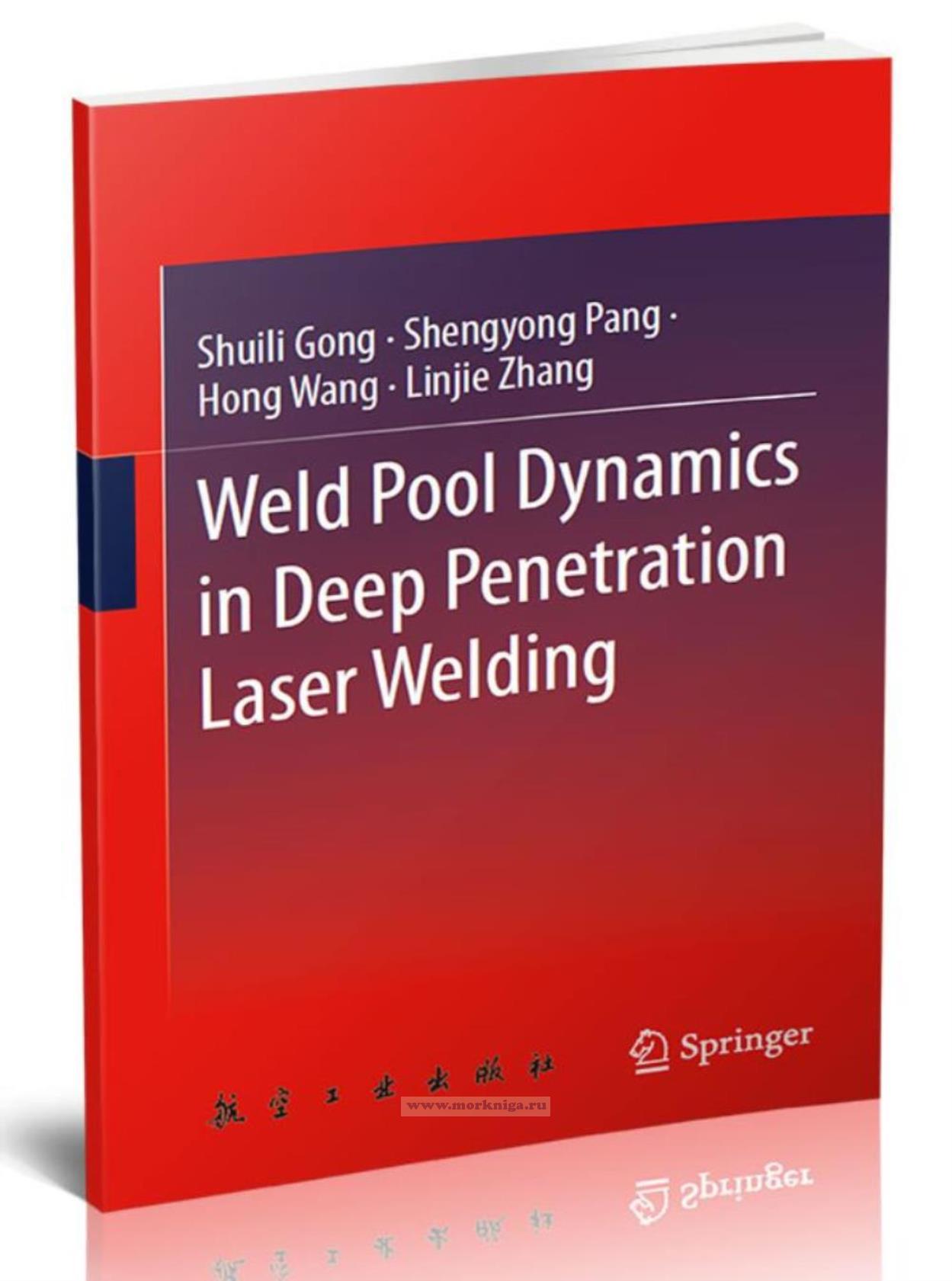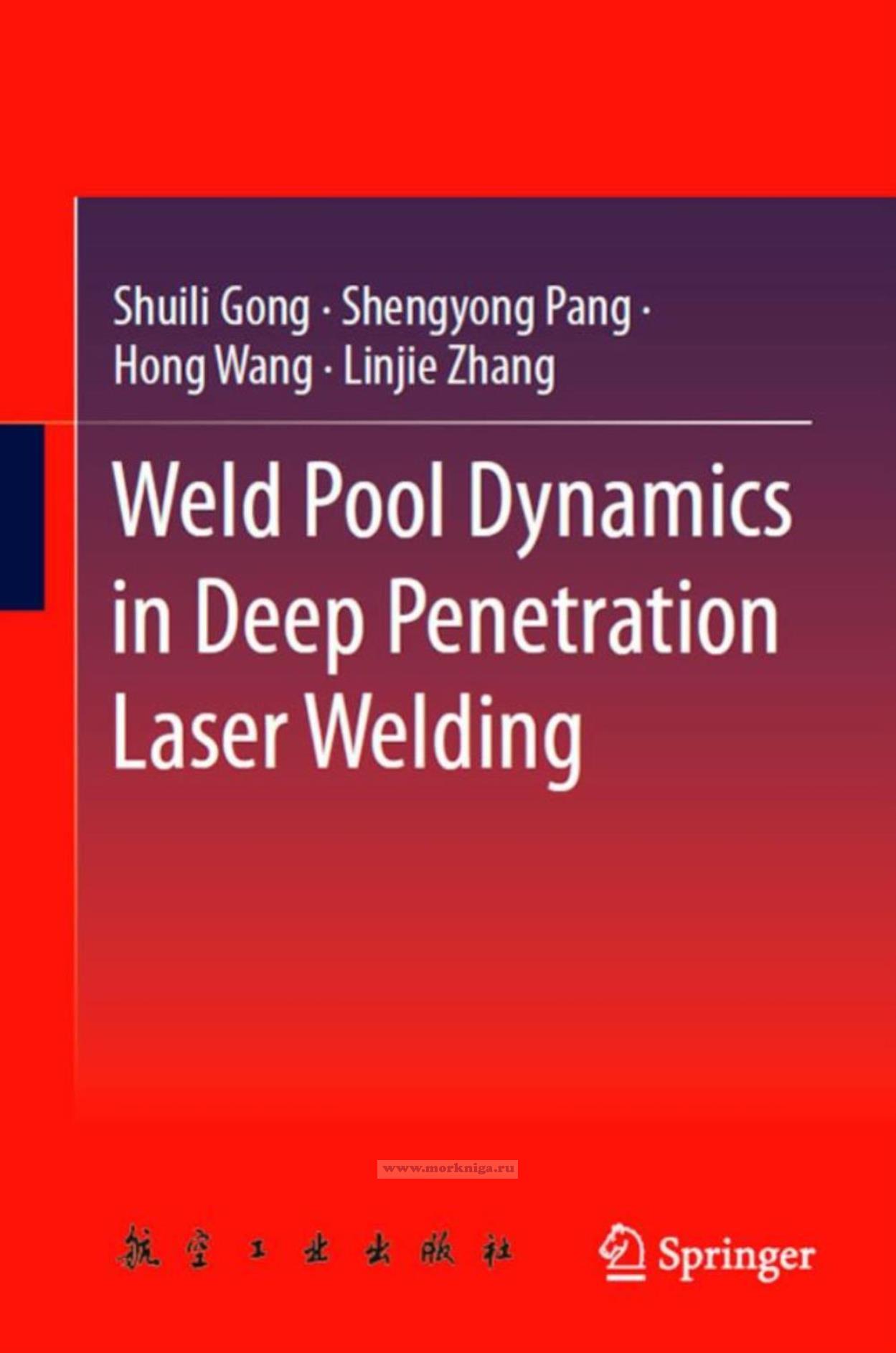Weld Pool Dynamics in Deep Penetration Laser Welding/–Ф–Є–љ–∞–Љ–Є–Ї–∞ —Б–≤–∞—А–Њ—З–љ–Њ–є –≤–∞–љ–љ—Л –њ—А–Є –ї–∞–Ј–µ—А–љ–Њ–є —Б–≤–∞—А–Ї–µ —Б –≥–ї—Г–±–Њ–Ї–Њ–є –њ–ї–∞–≤–Ї–Њ–є
–Ъ–љ–Є–≥–∞ –љ–∞ –∞–љ–≥–ї–Є–є—Б–Ї–Њ–Љ —П–Ј—Л–Ї–µ.
This book systematically describes the weld pool behavior in laser welding and its influencing factors from the perspectives of testing technology, theoretical calculation and process simulation technology, physical state transformation behavior of weld pools, and the impact of technical conditions on the weld pool behavior. The book covers extensive research achievements made in China in this field, some of which represent the latest cutting-edging researches conducted by the authors' research team. These latest research efforts mainly relate to the weld pool behavior of dual-beam laser welding, laser welding with filler wires, full-penetration laser welding of very-thick parts, and laser welding in vacuum and low vacuum conditions. The book is intended for undergraduate, graduate students and researchers who are interested in laser welding.
Contents
1 Laser Welding Basics
1.1 Interaction of Lasers andMaterials
1.1.1 Laser Absorption by Materials and Material Heating
1.1.2 Laser Heat Source Model and Laser Heating Effect
1.1.3 Material Melting Under Laser Action
1.1.4 Evaporation of Materials Under Laser Action
1.1.5 Laser-Induced Plasma and Its Effects
1.2 Principles and Characteristics of Laser Welding
1.3 Research on Weld Pool Behavior in Laser Welding
2 Model of Quasi-Steady Weld Pool Dynamics and Numerical
Simulation
2.1 Introduction
2.2 Basic Models of Quasi-Steady Laser Welding
2.2.1 Governing Equations of the Flow and Heat Transfer in Quasi-Steady Laser Welding
2.2.2 3D Mathematical Model of Deep Penetration Laser Welding Under Moving Heat Source
2.2.3 Heat Source Model in Deep Penetration Laser Welding
2.3 Implementation of Numerical Solution
2.3.1 Upwind Scheme
2.3.2 Staggered Grid Method
2.3.3 Pressure Correction Method for Solving Navier-Stokers Equation
2.3.4 SIMPLE Algorithm
2.3.5 Programming and Solving
2.4 Physical Properties and Calculation Parameters
2.5 Effect of Welding Speed on Keyhole Profile
2.5.1 Temperature Distribution in Deep Penetration Laser Welding of Titanium Alloys
2.5.2 Effect of Welding Speed on Keyhole Size
2.5.3 Effect of Laser Power on Keyhole Size
2.6 Simulation of Weld Pool and Keyhole in Deep Penetration LaserWelding
2.6.1 Numerical Simulation of Weld Pool Shape in Deep Penetration Laser Welding
2.6.2 Effect of Welding Speed and Laser Power on Weld Pool Size
2.7 Numerical Simulation of Fluid Flow in Weld Pool During Deep Penetration Laser Welding
2.7.1 Characteristics of Fluid Flow in Weld Pool
2.7.2 Distribution of Flow Velocity in Weld Pool
2.7.3 Verification
2.8 Summary
3 Coupling Model and Numerical Computation Method of Keyhole and Weld Pool
3.1 Introduction
3.2 Governing Equations of Coupled Model
3.2.1 Heat Transfer and Fluid Flow Equations
3.2.2 Heat Source Model
3.3 Free-Surface Tracking Method
3.3.1 Level SetMethod
3.3.2 VOFMethod
3.4 Boundary Conditions of the Coupling Model
3.4.1 Basic Agreements
3.4.2 Discontinuous Boundary Conditions in GasвАУLiquid Two-Phase Flow
3.4.3 Discontinuous Boundary Conditions for Surface Tension, Thermal Capillary Force and Recoil Pressure
3.5 NumericalMethod
3.5.1 Fast Solution of Laser Beam Energy Absorbed by Keyhole Wall
3.5.2 Keyhole Free Surface Tracking Method
3.5.3 Solutions for Coupling Free Surface Flow and Heat Transfer
3.5.4 Numerical Calculation Process
3.6 Summary
4 Simulation of Transient Keyhole and Weld Pool
4.1 Introduction
4.2 Transient Coupling Dynamics of Keyholes and Weld Pool
4.2.1 Dynamic Evolution Process and Characteristics of Keyholes
4.2.2 Flow Characteristics of Weld Pool with Stable Keyhole
4.2.3 Flow Characteristics of Weld Pool with Unstable Keyhole
4.3 Effects of Physical Factors on the Coupling Behavior
4.3.1 Interfacial Force and Multiple Reflections and Absorptions
4.3.2 Thermophysical Parameters
4.3.3 Welding Process Parameters
4.4 Summary
5 Dynamic Behaviors of Metal Vapor/Plasma Plume Inside Transient Keyhole
5.1 Introduction
5.2 Dynamic Model of Metal Vapor/Plasma in Transient Keyhole
5.2.1 Governing Equations
5.2.2 Boundary Conditions
5.3 Dynamics of Metal Vapor/Plasma in Transient Keyhole
5.3.1 Uneven Distribution and High Transient
5.3.2 Multi-directional Flow Behavior in the Keyhole
5.3.3 Violent Oscillation and Swinging Behavior
5.3.4 Compressibility at Local Evaporation
5.4 Conclusion
6 Behaviors of Keyhole and Weld Pool Under the Effect of Side-Blown Gas
6.1 Introduction
6.2 Flow Field of Side-Blown Shielding Gas (for Titanium Alloy)
6.3 Behaviors of Keyhole and Weld Pool Under the Effect of Side-Blown Gas
6.3.1 Deformation of Weld Pool Surface Under the Effect of Side-Blown Gas
6.3.2 Behaviors of the Keyhole and Weld Pool Under the Combined Effects of Metallic Vapors and Side-Blown Gas
6.4 Influences of Side-Blown Gas on the Stability of the Keyhole and Weld Pool
6.5 Conclusions
7 Keyhole and Weld Pool Dynamics in Dual-Beam Laser Welding
7.1 Introduction
7.2 Transient Coupling Model of Keyhole and Weld Pool in Dual-BeamWelding
7.2.1 Control Equation of Transient Coupling Model
7.2.2 Boundary Conditions of Transient Coupling Model
7.3 Coupling Behavior of Keyhole and Weld Pool in Dual-Beam Welding
7.3.1 Evolution Behavior of Dynamic Keyhole in Welding
7.3.2 Flow Behavior of Moving Weld Pool in Welding
7.4 Mechanism and Influencing Factors of Stability of Dual-Beam Welding
7.4.1 Stability Mechanism of Dual-Beam Welding
7.4.2 Influence of Process Parameters on Stability of Dual-BeamWelding
7.5 Summary
8 Keyhole and Weld Pool Dynamics in Laser Welding with Filler Wires
8.1 Introduction
8.2 Multiphase Transient Coupling Model in Laser Welding with Filler Wires
8.2.1 Mathematical Model of Wire Melting
8.2.2 Transient Coupling Model of Keyhole and Weld Pool
8.2.3 Boundary Conditions
8.3 Keyhole and Weld Pool Dynamics in Welding with Filler Wires
8.3.1 Behaviors of Transient Keyholes and Weld Pools Under Free Transition Conditions
8.3.2 Influences of Wire Feed Speed on Transient Keyhole and Weld Pool Behaviors in Free Transition
8.3.3 Influences of Wire Diameter on Transient Keyhole and Weld Pool Behaviors in Free Transition
8.3.4 Transient Keyhole and Weld Pool Behaviors Under Contact Transition Conditions
8.3.5 Influences of Wire Feed Speed on Transient Keyhole and Weld Pool Behaviors in Contact Transition
8.3.6 Influences of Wire Diameter on Transient Keyhole and Weld Pool Behaviors in Contact Transition
8.3.7 Comparison of Transient Keyhole and Weld Pool Behaviors in Free Transition with Those in Contact Transition
8.4 Instability of Keyhole and Weld Pool in Welding with Filler Wires
8.4.1 Weld Pool Dynamics in Single Beam Laser Welding and Laser Welding with Filler Wires
8.4.2 Weld Pool Dynamics in Welding with Filler Wires Under Different Wire Feed Speeds
8.4.3 Mechanism of Keyholes Instability in Welding with Filler Wires
8.5 Dynamic Dilution Behavior of Moving Weld Pools in Welding with Filler Wires
8.5.1 Model of Dilution in Weld Pools
8.5.2 Dynamic Dilution Behavior in Quasi-Steady Weld Pools
8.5.3 Dynamic Dilution Behavior in Transient Weld Pools
8.6 Summary
9 Dynamical Behaviors of Keyhole and Weld Pool in Vacuum Laser Welding
9.1 Introduction
9.2 Transient Coupling Model of Keyhole and Weld Pool in Vacuum
9.2.1 Governing Equations in Vacuum Laser Welding
9.2.2 Boundary Conditions in Vacuum Laser Welding
9.3 Behaviors of Keyhole and Weld Pool in Vacuum Laser Welding
9.3.1 Dynamical Keyhole Evolutions
9.3.2 Moving Weld Pool Flow Patterns
9.4 Penetration Depth Increase in Laser Welding Under Vacuum and Low Vacuum Conditions
9.4.1 Mechanism for Penetration Depth Increase with Ambient Pressure Decrease
9.4.2 Finite Increase of Penetration Depth
9.5 Summary
Bibliography

